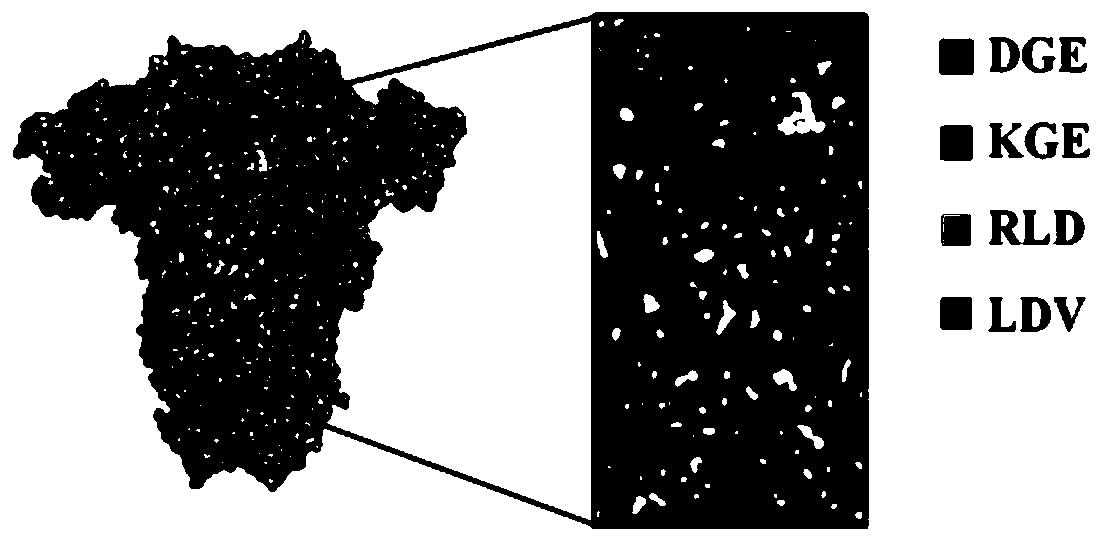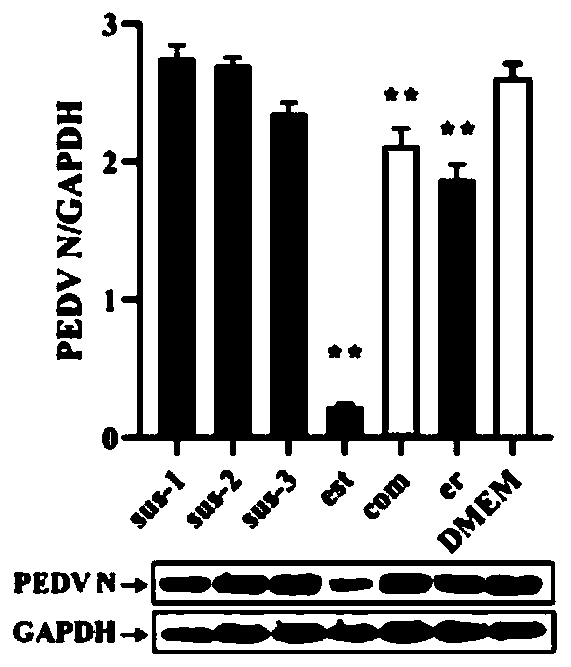Research method for restraining porcine epidemic diarrhea virus infection based on integrin ligand recognition peptides
A technology for porcine epidemic diarrhea and virus infection, applied in the field of porcine epidemic diarrhea virus infection, to achieve the effects of preventing virus infection, simple processing technology, and low production cost
- Summary
- Abstract
- Description
- Claims
- Application Information
AI Technical Summary
Problems solved by technology
Method used
Image
Examples
Embodiment 1
[0046] A research method for inhibiting porcine epidemic diarrhea virus infection based on an integrin ligand recognition peptide, comprising the following steps,
[0047] S1: Dilute Vero E6 cell suspension grown and maintained in high-glucose DMEM medium containing 10% fetal bovine serum and 1% penicillin-streptomycin solution to 1×10 5 pc / mL, inserted into 100cm 2 Cell culture dish, shake gently to distribute cells evenly, then place in 5% CO 2 , cultured in a 37°C cell culture incubator;
[0048] S2: when the density of Vero E6 cells reaches 90%, the culture medium is discarded, and the Vero E6 cells are rinsed;
[0049] Specifically, Vero E6 cells were gently rinsed three times with PBS, and then rinsed once with serum-free DMEM basal medium.
[0050] S3: Add the rinsed Vero E6 cells into the basal medium containing 40 μmol integrin ligand recognition peptide, and incubate in a cell culture incubator at 37°C for 6 hours;
[0051] Specifically, the integrin ligand recog...
Embodiment 2
[0077] The difference between Example 2 and Example 1 is that the integrin ligand recognition peptide used is com, and other operations are the same.
Embodiment 3
[0079] The difference between Example 3 and Example 1 is that the integrin ligand recognition peptide used is er, and other operations are the same.
[0080] Further, the research results in Example 1 and Example 3 are as follows:
[0081] 1. Analysis of integrin ligand recognition sequence in PEDV S protein
[0082] Import the PEDV CV777 strain S protein amino acid sequence (GenBank: AF353511.1) downloaded from the NCBI database into the Editseq software to search for the integrin ligand recognition sequence, as shown in Table 3. The integrin ligand recognition sequence DGE is located in Amino acids 1133-1135, KGE at amino acids 621-623 and 655-657, RLD at amino acids 1070-1072, IET at amino acids 67-69, LDV at amino acids 643-645 and 1266 -1268 amino acids, IDS is located at 81-83 amino acids.
[0083] Table 3 The position of integrin ligand recognition sequence in PEDV S protein
[0084]
[0085] Download the S protein model (PDB: 6U7K) of PEDV classic strain CV777 in...
PUM
 Login to View More
Login to View More Abstract
Description
Claims
Application Information
 Login to View More
Login to View More - R&D
- Intellectual Property
- Life Sciences
- Materials
- Tech Scout
- Unparalleled Data Quality
- Higher Quality Content
- 60% Fewer Hallucinations
Browse by: Latest US Patents, China's latest patents, Technical Efficacy Thesaurus, Application Domain, Technology Topic, Popular Technical Reports.
© 2025 PatSnap. All rights reserved.Legal|Privacy policy|Modern Slavery Act Transparency Statement|Sitemap|About US| Contact US: help@patsnap.com



